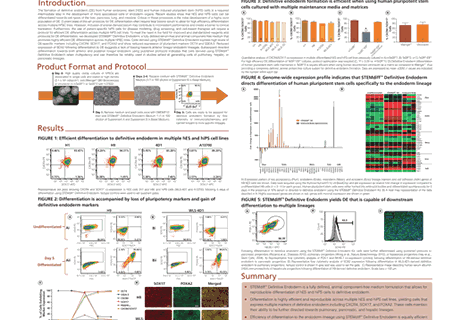
Highly efficient differentiation of human pluripotent stem cells to multipotent definitive endoderm using the serum-free and animal component-free STEMdiff Definitive Endoderm Culture System
Michael J. Riedel1, Stephanie Lam1, Terry E. Thomas1, Allen C. Eaves1,2, and Sharon A. Louis1
1. STEMCELL Technologies Inc., Vancouver, BC, Canada
2. Terry Fox Laboratory, BC Cancer Agency, Vancouver, BC, Cana
Introduction
The formation of definitive endoderm (DE) from human embryonic stem (hES) and human induced pluripotent stem (hiPS) cells is a required intermediate step in the development of more specialized cells of endoderm organs. Recent studies show that hES and hiPS cells can be differentiated towards cell types of the liver, pancreas, lung, and intestine. Critical in these processes is the initial development of a highly pure population of DE. Current state-of-the-art protocols for DE differentiation often require fetal bovine serum to allow for high efficiency differentiation across multiple hPSC lines. However, inclusion of animal-derived serum may contribute to inconsistent performance and create a barrier to clinical translation. Furthermore, the use of patient-specific hiPS cells for disease modeling, drug screening, and cell-based therapies will require a protocol for efficient DE differentiation across multiple hiPS cell lines. To meet the need in the field for improved and standardized reagents and protocols for DE differentiation, we developed STEMdiff™ Definitive Endoderm, a fully defined serum-free and animal component-free medium that promotes highly efficient DE differentiation across multiple hPSC lines. Cells derived using STEMdiff™ Definitive Endoderm express high levels of DE-specific markers including CXCR4, SOX17, and FOXA2 and show reduced expression of pluripotent markers OCT4 and SSEA-3. Reduced expression of SOX2 following differentiation to DE suggests a lack of biasing towards anterior foregut endoderm lineages. Subsequent directed differentiation towards both anterior and posterior foregut endoderm using published protocols indicates that cells derived using STEMdiff™ Definitive Endoderm retain multipotency and can therefore be reliably used in studies aimed at generating cells of pulmonary, hepatic, or pancreatic lineages.